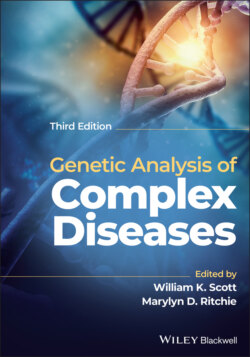Читать книгу Genetic Analysis of Complex Disease - Группа авторов - Страница 81
Summary
ОглавлениеThe analyses presented in this chapter will aid in determining whether genes play an important role in a condition or trait. It is important to establish a genetic basis before embarking on more elaborate analyses such as whole genome scans using linkage and/or association analysis because of the ethical, financial, and labor challenges associated with them. However, the first step in the analytic process should be a thorough examination of the literature. Often, because complex disorders are common and of public health importance, many of the analyses discussed in this chapter will have been previously completed by other investigators. Therefore, there may already exist sufficient evidence to support the involvement of genetics in the etiology of the disorder under investigation but evaluate the literature critically, keeping in mind how the study population (including age and ethnicity) and phenotype was defined in each of the published analyses. Significant deviations from the definition of one’s own study population and phenotype may suggest that prior results do not generalize to the present study and may necessitate repeating of the analyses described in this chapter.
If one determines that the types of analyses presented in this chapter (or any of the other chapters) must be performed, give careful consideration to study design prior to collecting and analyzing the data. Study design will influence the types of biases introduced into the data and can limit the types of analyses that may be performed.
Pay careful attention to the types of bias in the data. Ignoring ascertainment biases and confounding factors (age, ethnicity, etc.) may lead one to the wrong conclusions. If control samples are utilized, one must ensure that they are properly matched to the cases for confounding factors. When historical data are obtained on family members, follow up with examination of medical records or physical examination of those individuals to corroborate the information whenever resources allow. If a late‐onset disorder is being studied, re‐examine “unaffected” individuals after a period of time to confirm that they are truly unaffected and not misclassified because they were too young to express the disorder.
Keep in mind that for complex genetic disorders, there may be a high percentage of the patient population for whom the disorder is sporadic (no other affected family members), and the genetic mechanisms that lead to complex disorders may or may not be the same in familial and sporadic cases. For example, the BRCA1 gene that has been implicated in familial cases of breast cancer is not frequently mutated in cases of sporadic breast cancer (Easton et al. 1993; Futreal et al. 1994). This caveat is also important when comparing genetic mechanisms for early‐onset versus late‐onset familial versions of a disorder.
Finally, recognize that statistical associations for familial clustering may not represent a genetic etiology for a disorder but may be due to a common familial environment, or simply chance. The definitive evidence that a disorder is genetic is the identification of the specific genetic variations that lead to the condition.
